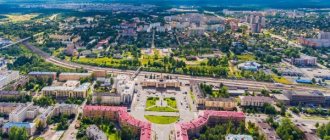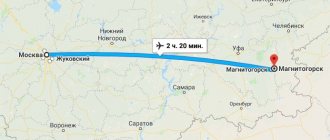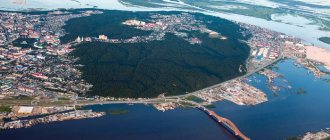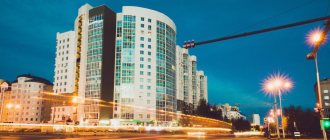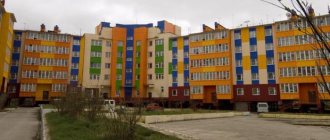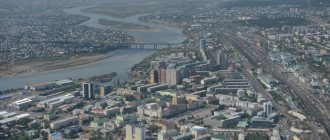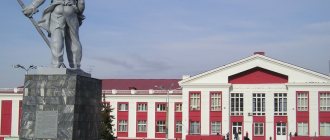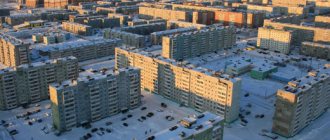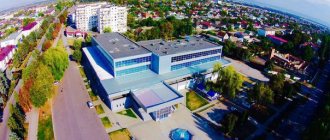The importance of the city in the modern world
In the 20s of the last century, the first expeditions to study Siberian deposits were sent to the Taimyr Peninsula under the leadership of Nikolai Urvantsev.
A scientist with a capital S, passionate about the Arctic, who convinced the capital’s leadership to send an expensive geological exploration expedition to Taimyr, and after 2 years of research presented a complete picture of the area with deposits of platinum, gold, and nickel, Norilsk residents consider him the founder.
So, in 1939, a working settlement of the same name was created near the Norilskaya River, which became a city in 1953. The urban district includes two settlements: the city of Norilsk and the urban village of Snezhnogorsk, whose area is 4,500 square meters. km (450900.85 ha).
The territorial location united the city-districts into “Big Norilsk”:
- Kayerkan;
- Talnakh;
- Oganer Residential Education;
- village of Snezhnogorsk.
Norilsk on the map of Russia can be seen above the Arctic Circle, at the 69th parallel: 69.35 north latitude and 88.20 east longitude. The city border approaches 70 degrees north latitude and borders the Taimyr Dolgano-Nenets municipal district.
Norilsk is located on one of the largest peninsulas - Taimyr.
Therefore, outside this peninsula, locals call the land “mainland”. The distance between the city and the regional capital is 1550 km. There are roads and railways from Norilsk only to the port city of Dudinka. In summer, when navigation is available, the northern city can be reached along the Yenisei River.
The journey will take from 3.5 to 6.5 days, depending on which direction the ship is going, the price category is within 31,000 rubles. (luxury cabin) up to 23,000 rub. (1st class cabin). This route is made mainly as an excursion. In Krasnoyarsk, travel companies offer 7-9-day tours along the route “Krasnoryask-Norilsk” with the aim of looking at the Siberian beauties, impenetrable taiga and tundra.
The cost of the tour as a holiday in a five-star hotel abroad is from 70,000 rubles. for 1 person. Norilsk residents also use river transport, carrying multi-ton cargoes of industrial and food products to Norilsk for the long winter. There is constant air traffic through the Alykel airport.
From Norilsk you can fly directly to the following cities:
| Arrival city | Travel time | Ticket price (category: economy class) |
| Krasnoyarsk | 2.5 hours | from 10,000 rub. |
| Moscow | 4.5 hours | from 15,000 rub. |
| Novosibirsk | 3 hours | from 12,000 rub. |
| Saint Petersburg | 4 hours 20 min. | from 15,000 rub. |
Other destinations are reached with transfers, mainly through Moscow, travel time is from 1 day.
The most interesting things about Norilsk
Hearing the name “Norilsk”, an association arises with nickel and tungsten. It was these two minerals, generously donated by nature to this region, that made the city a major industrial center of the country.
The first inhabitants came to this place in the Bronze Age, settling near the Norilka River. In ancient times, it was rich in fish, and the poles for catching it were called “norilo”, hence the name of the settlement.
To the question of which region Norilsk is located in, any resident of the Northern cities knows the answer - in the Krasnoyarsk Territory.
Distinctive features of the city
Norilsk is a special city, from its remoteness from the mainland to the technology of residential construction. Such features seem ordinary to local residents, but surprising to tourists.
Climate
There are many northern cities on the map of Russia. They all have their own climatic characteristics. Norilsk is considered one of the windiest cities in the world. Wind movement is often recorded as 30-40 meters per second, and in winter it develops into a snowstorm. The expression “3 months of summer, the rest is winter”, by the way, is perfectly suitable for the city.
Above-zero temperatures occur only in June, July, and August. There are summer days when the air warms up to 32 degrees, but summer is often rainy. The rest of the time the temperature is low, reaching -56C in the winter. May and September are no exception. Winter is always snowy, up to 2 million tons of snow falls, and this is the main problem of off-roading in the city.
Abnormally low temperatures often cause suspended days, where students and preschool children do not attend educational institutions until favorable weather conditions are established. Often, for primary school children, school holidays last for several months.
They are also allowed to stay until the beginning of the school year for the entire month of September so that they can spend longer at seaside resorts or in cities with a milder climate.
Ecology
Norilsk is without a doubt the largest industrial center in Russia. Due to the extraction of natural resources, industrial complexes and factories have been built in the city, which cause enormous environmental damage. By throwing waste into water bodies, treatment plants cannot cope with water filtration.
Norilsk is a very dirty city, as there are factories there that emit hazardous waste.
This is the reason for poor drinking water in the city and unsuitable water bodies in the area. Forests of little value for production and sale are not cut down and “bald” or yellowish coniferous trees can be seen.
Over the city, local residents constantly observe smog due to the prohibitive content of harmful substances in the atmosphere, which exceeds the norm by 5 times. The most polluted air is felt in the Central region (Norilsk itself), near which all industrial complexes are located. The satellite city of Talnakh is farthest from production, and the environment is considered better.
In recent years, the solution to the environmental problems of the northern city has been under the control of the federal government. Factories are being modernized in terms of measured emissions of pollutants.
However, today Norilsk is among the world's hundred and ten environmentally-dirty cities in Russia.
There is an increased percentage of people with pulmonary diseases, allergies, mental disorders; oncology is 2 times higher.
Population (numbers, peoples)
The local peoples of Norilsk include the Dolgans, Nenets and Entsy. However, they make up a smaller percentage. The majority are Russians, Ukrainians, and Azerbaijanis. In total, according to population data in 2018, the number was just over 180,000 people, a constant “increase” is made by citizens who arrived for long-term rotational work.
Norilsk has a social program to facilitate the resettlement of citizens from the Far North to cities with more favorable living conditions. Preferential rights are given to pensioners, disabled people, people who were born and (or) began their working career in the city during Soviet times and do not have other living space outside Norilsk.
Houses on stilts
Norilsk is built on a surface with permafrost, which goes 300-500 m underground. Construction of residential buildings is not an easy task for city builders. When heat enters, the soil thaws, and the building may crack and subsequently collapse.
However, in the late 50s, the pile foundation method was discovered, which consisted of building houses on stilts, which in turn were placed in wells drilled into the permafrost in advance.
The method made it possible to reduce the labor costs of constructing the foundation by 10 times, and their cost by 2 times.
Since the beginning of the 60s, all houses in Norilsk have been built using this method. This experience of Norilsk builders was adopted by Dudinka, Yakutsk, Vorkuta and other northern cities.
Flora and fauna
Norilsk on the map of Russia is located on the Taimyr Peninsula. It is impossible to talk about the flora and fauna of Norilsk separately from Taimyr. Here are its large-scale nature reserves, untouched wild nature, and impenetrable forest-tundra.
Brown bears, wolves, and foxes live in the forest belt nearby. Predators do not enter the city, but they can be found at dachas and countryside camp sites that are empty in winter. Old-timers claim that until the 80s there were deer on the roads.
In the central part of Norilsk there is Lake Dolgoye. Previously, it served residents of the city as a source of drinking water, a place for beach recreation, and fishing. Nowadays this reservoir is used for technological purposes at the city thermal power plant. But fishing lovers visit various other lakes, of which there are hundreds in the Norilsk area.
The following fish are caught for sale or for their own fishing needs:
- sturgeon;
- whitefish;
- burbot;
- pike;
- cod;
- muksuna;
- omul
There are hundreds of species of plants. Directly within the industrial zones, everything is contaminated with waste.
However, Siberian frost-resistant seed plants include:
- needles;
- larch;
- moss;
- various kinds of lichens;
- "roasting" bushes.
polar night
The polar city of Norilsk is a region of the Far North, which is characterized by short daylight hours in winter. The polar night is accompanied by twilight in the daytime, where the sun does not emerge from the horizon, or its thin stream is visible, and daylight hours do not exceed 4 hours.
The polar night in Norilsk lasts from 43 to 45 days, from late November to mid-January. During this period, temperature changes occur, which have the same name “polar night syndrome”; residents complain of drowsiness, lethargy, and jet lag associated with a lack of oxygen and a lack of vitamin D obtained from sunlight.
A real estate expert spoke about what is happening with the housing market in Norilsk
The rise in prices on the housing market in Norilsk began in the summer, but if in previous years it was seasonal (autumn and spring), now, apparently, prices are not going to slow down yet. Real estate expert Anna Savina told Severny Krai about what is happening with the market.
They're buying everything!
There has always been a fairly wide range of housing prices in Norilsk. This is due to the fact that demand in the territory traditionally exceeds supply: here and there workers are needed, and accordingly, shift workers are brought in and need to be housed somewhere. And this is against the backdrop of the fact that for many years almost no new housing has been built in Norilsk. Norilsk residents, not without reason, associate wild prices on the housing market with the largest influx of specialists into the city in recent years - to work on large projects, including those related to long-term plans for the renovation and development of the city.
- Now they are buying everything! – says Anna Savina. “If, for example, ten three-room Khrushchev apartments appear on the market, then there will immediately be ten buyers for them. Again, the choice is small, or rather there is none. For example, a buyer is looking for a “one-room apartment” in a nine-story building, and looks at 5 or 10 relatively suitable options. But! Some of the apartments are located on the extreme floors - on the 1st and 9th, others are in terrible condition and in fact it turns out that there is practically zero choice. In the best case, out of ten options, only 1 will be more or less suitable.
The corridor of an ordinary Norilsk hotel. Photo by Viktor Ivanov
In addition, buyers often look for apartments on a specific street (it is very cold in winter, so the issue of distance greatly influences the choice). And they are offered options, for example, on the Embankment or Nansen. However, today this has almost no effect on the excitement: even apartments that are not suitable for the area and “killed”, despite their dubious attractiveness, are sold in a short time (less than a month). Anna says that Norilsk residents are increasingly considering buying real estate as a way to invest and earn extra income. 50% of apartments or so are bought for rent.
Renting an apartment in Norilsk today will cost a pretty penny. And the amount is substantial, from 30 to 80 thousand rubles per month. On average, a one-room apartment in a good area with furniture and household appliances is rented for 50 thousand rubles. They are trying to make money even on a mortgage. It's simple arithmetic: we take out a mortgage on a one-room apartment for two million rubles, rent it out for 50 thousand rubles a month - it will bring a profit of 600 thousand rubles a year. And it will fully pay for itself in an average of 3 years.
“It’s very fast,” says Anna Savina. - On the mainland there is a good payback - 5 years. And it happens that even during this period the housing does not justify the money invested in it. So, in St. Petersburg, a one-room apartment costs seven million; it is rented for 30-40 thousand rubles per month. The payback period is many times longer. Nowhere in Russia is there such a rental now as in Norilsk! And especially among cities comparable in population to Norilsk, although housing prices in cities with a comparable population are similar to ours.
Finest hour
European-quality renovation of a bathroom in a Norilsk high-rise building. Photo by Viktor Ivanov
Thanks to the sulfur project of Norilsk Nickel (environmental program - author's note), Kayerkan's finest hour has come. Until recently, this was not the most popular area for living, because in winter it is often very difficult to get there due to snowstorms. Today is a full house. Anna Savina, for example, had a buyer who bought 10 one-room apartments here in one day. Back in July, a one-room apartment could be bought here for 500,000 rubles, today – an average of 1.5 million rubles. The growth is unprecedented.
And at the same time you have to buy what they give. Often, for example, the interiors in apartments are, as they say, eye-catching. The interior preferences of Norilsk residents and their idea of European-quality renovation are generally a separate topic. Repairs, of course, give a decent markup, but... Black or green ceilings, parrots or huge flowers on the walls, wallpaper like in Versailles and plastic stucco in Khrushchev - in general, realtors often stumble upon outright kitsch. And such apartments come across one after another.
“In my understanding, European-quality renovation means neutral shades of wallpaper and walls, laminate flooring, parquet on flat floors, plastic windows, tiles in the bathroom, good new furniture, European standard sockets and the necessary minimum of household appliances: stove, oven,” says Anna. — A person must buy an apartment and live in it until the next renovation, which can happen in ten years.
But today even abandoned apartments are falling into disrepair. But housing with a very unique (in the opinion of the owners) renovation and therefore overpriced is hanging on the real estate market. It is very expensive and troublesome to equip such apartments to your liking. An example of this is the “three ruble” apartment on Khantayskaya, the walls of which are decorated with plaster stucco molding and frescoes. The owner valued it at 2.9 million.
Bedroom in a “killed” Khrushchev building. Photo by Viktor Ivanov
BY THE WAY
How much is the apartment?
The price of an apartment in Norilsk depends on the area, series of the house, floor, presence or absence of renovation, furniture, household appliances, developed infrastructure: kindergartens, schools, shops. Recently, for example, a one-room apartment sold for 2.8 million rubles. The renovation is many years old, but the owner took care of the apartment. A buyer was found instantly.
A three-room Khrushchev apartment without renovation, on the fifth floor, was recently bought for 3.2 million rubles. And it's considered cheap. A “treshka” in a house of 84 series (more than 70 square meters – approx.) costs approximately 4 million rubles. However, today there are 4 million “one-room apartments” each – this won’t surprise anyone. The most expensive apartment in Norilsk today went for 10 million rubles.
Realtors take the average cost of one square meter as a guide in the price space, which is now about 60-70 thousand rubles per meter in Norilsk.
LOOK BACK
In 1998, large sums were allocated for relocation from dilapidated and dilapidated housing, and the Housing Fund became the first major buyer of apartments in Norilsk. Because of this, from 1998 to 2002, prices for Norilsk real estate increased 10-15 times. The price of a one-room apartment in 1998 was 20 thousand rubles, rising to 200-250 thousand rubles by 2002.
In 2010, a resettlement program from the Far North began. Norilsk residents received an amount equal to the cost of an apartment in the most expensive regions of our country; the apartments were not sold, but were exchanged for certificates. At this time, the one-room apartment cost one million rubles.
The next increase in real estate prices occurred in 2017 after the closure of the Nickel Plant. Many workers transferred to enterprises in Talnakh, a great demand for housing arose, prices here tripled and became equal to the Central District of Norilsk.
Another 1.7-fold increase in prices from the beginning to the end of 2022 occurred throughout the country.
INTERESTING
At the beginning of 2022, 2.5 thousand apartments were sold on the real estate market of Norilsk, Talnakh, Kayerkan and Oganer, but now only 600 are on sale. The number of offers for the sale of housing has decreased by 4 times, and the demand for it is growing. The reason is that new houses are not being built, and as long as there are few apartments on the real estate market, the price will remain on the rise.
Transport of Norilsk
In Norilsk there are no railway tracks at all, including a tram. There are only roads in the city; outside the city there is tundra.
Buses
The most common public transport is the bus. Route stops can be seen frequently and everywhere. Due to the climatic characteristics of the northern city, stops are located no further than 500 meters from residential buildings. The municipality has identified about 30 routes, the starting time depending on the destination is 4-6 a.m., almost all routes run until midnight.
The frequency of municipal transport is from 15 to 30 minutes. A trip to neighboring areas from the central one will cost 40 rubles. Social tickets are also available for certain categories of residents at a reduced price.
Minibuses
Minibus taxis are presented mainly in directions to and from Alykel airport, which is located 50 km from the city. The trip will cost a little more than in municipal vehicles, but the minibus copes with its task better: it has a short travel time and is more maneuverable on the roads. It is possible to get to both the central region of Norilsk and Talnakh.
Taxi
There are about 23 taxi services in the Norilsk district. They are represented by both federal networks (Yandex taxi) and local ones with colorful names - “Northern City”, “Zapolyarye”, “White Leopard” and others. Since the area of Norilsk itself is small and not burdened with traffic jams, the wait does not take more than 7 minutes. any time of the day.
The price of a trip around central Norilsk with an economy class taxi is from 80 rubles, to the airport - within 1,000 rubles, to other areas of the city - from 250 to 450 rubles, depending on the distance from the city center.
Rent a Car
You can rent a car either from private hands or through car rental companies. Car owners are considering daily, weekly and monthly rentals.
The price per day for a small car (Mazda Demio) will be from 1,000 rubles, with a larger engine and a later release date - from 2,000 rubles. Auto centers offer passenger cars for personal and business needs - from 2,500 rubles. and minivans - from 3,000 rubles. per day.
Car owners guarantee:
- technical serviceability;
- clean, odor-free interior;
- MTPL insurance without restrictions;
- accident insurance;
- unlimited mileage for the rental period.
Norilsk Airport
There is an airport of federal significance in Norilsk. Type of airfield: jointly based: military aviation is based here along with civil aircraft. The distance from the city center to the airport is 36 km towards the west. The airport is open every day from 23:00 to 10:00. Norilsk Airport is the only connection between the north of the Krasnoyarsk Territory and other regions of the Russian Federation.
The airport serves aircraft of major Russian airlines: S7 Airlines, KrasAvia, NordStar. Popular destinations of regular flights: Krasnoyarsk, Ufa, St. Petersburg, Moscow, Novosibirsk. The annual passenger traffic is more than 500 thousand people.
Main attractions
Norilsk is rich in attractions in moderation. They are mainly associated with the memory of the formation of the city, geological exploration work, and difficult times of exile.
"The first house of Norilsk"
The very first house in Norilsk is a museum exhibit. A wooden one-room log house built in 1921, which was built by the first expedition of N. Urvantsev for wintering. Inside the house there is a museum of the life of the founders of those years. The house is located in the center of Norilsk.
The museum and exhibition complex "Museum of Norilsk", which includes the first house of geologists, is open from Tuesday to Sunday from 11 to 19 hours, on Friday the working hours are shifted from 13 to 21 hours. Price for visiting the first house in Norilsk: 120 rubles, schoolchildren, preschoolers and pensioners have benefits.
Norilsk Industrial Institute
Federal State Budgetary Educational Institution of Higher Education "Norilsk State Industrial Institute" produces specialists mainly in mining engineering. As additional specialties: management and economics. Training is provided on a full-time and part-time basis on a paid basis.
The price of annual training in technical specialties reaches 207,000 rubles. per year full-time and 65,000 rubles. by correspondence, respectively. There are quota places with a certain system of discounts for applicants.
The institute building is located in the center of Norilsk, all information is presented on the website, including:
- class schedule for students;
- ads;
- regulations;
- admission rules for applicants;
- Open days.
Temple of All Who Sorrow Joy
The Cathedral of the Icon of the Mother of God of All Who Sorrow Joy is located in the center of Norilsk and can be reached by minibus. It is difficult not to notice, since it is a large building with the corresponding attributes - domes, arches, columns.
Construction of the temple lasted from 1991 to 1993. Represented by church architecture and decoration. Divine services and liturgies are held as scheduled, admission is free.
Noord-Kamal Mosque
The Nurd Kamal Mosque is celebrated as the northernmost mosque in the world. The building was built in 1998, construction lasted 5 years at the expense of the ethnic Tatar entrepreneur M. Bikmeev. Architecture of Islamic orientation.
Taking into account the climatic features of the location, the traditional round shape of the tower, from which one is called to prayer, was replaced with a quadrangular one during the design process, which allows for better heat retention and being windproof. The mosque is located on the outskirts of the city, public transport is represented by 9 routes. Opening hours: daily from 8 am to 10 pm, admission is free.
Norilsk Polar Drama Theater named after Vl. Mayakovsky
Norilsk Polar Drama Theater named after. V. Mayakovsky has been running for the 78th season. Offers performances for children and adults. It is an indispensable place to visit for people on a long stay in Norilsk. On weekdays, evening performances begin at 7 p.m., on weekends at 6 p.m.
Monument to the Victims of Norillag
The most memorable landmark of the city is the monument to the “Victims of Norillag”, which was opened in the early 2000s. This is a writhing figure of a man in the light in a rectangular masonry in a vertical position, entwined with a wreath of intertwined hands.
It represents the Norilsk forced labor camp, founded in 1935 and which existed for more than 2 decades. More than 400 thousand people became victims of the totalitarian regime who passed through Norillag. The monument to the repressed is located in the city center.
Zapolyarnik Stadium
The Norilsk Zapolyarnik stadium has been functioning smoothly for 8 years after reconstruction. Designed mainly for playing football. The field is equipped with materials that meet modern standards. Accommodates 1000 spectators.
Strength training and wrestling classes are also held in the stadium building. Skate rentals are available in winter. Open daily, from 7 to 23 hours, skate rental - from 150 rubles, with your own equipment - free.
Monument to the chair
An unusual monument, which has significance only in the conjectures of residents and visitors of the north, is located in the city center on Leninsky Prospekt. It is a large reinforced concrete chair on a pedestal with steps.
Norilsk Golgotha
A terrible place because of its history - within the boundaries of the cemetery of Norillag prisoners who died from exhausting labor in unbearable climatic and social conditions, the memorial complex “Norilsk Golgotha” was created. The number of those buried is unknown, but all the remains were collected and buried.
The monument was built at the foot of Mount Schmidt and is a complex of buildings:
- Orthodox chapel;
- stele with information board;
- monuments to Poles, Jews, Balts.
Due to the distance from the city district, you can get to the monument individually by taxi.
Monument to a girl geologist
The main focus of the city is geological exploration and processing of minerals. The initiators decided to create a monument that personifies the unbreakability of the harsh conditions of the Russian people in female form.
The bronze figure of a girl stands on a pedestal, which can be reached by stairs.
The monument is located near Lake Dolgoye and is a favorite place for newlyweds. The most convenient way to get to the pedestal is by taxi.
Memorial "Black Tulip"
The “Black Tulip” memorial was created in memory of the soldiers called up from Norilsk to the Afghan, Chechen and other local wars. Depicted as a black tulip flower in an arched frame, on top of which is an eight-pointed star - a symbol of military valor.
The monument is located in the center of Norilsk, 4 public transport routes lead to it.
Gorge "Red Stones"
The Red Stones gorge is located in Kharaely - a mountainous area, not far from the Talnakh region. The indescribable beauty of the waterfall forms a transparent lake, up to 9 meters deep. The reservoir is surrounded by mountains, the stones of which have a red tint, hence the name of the same name. The rocky terrain attracts not only vacationers, but also climbers. You can get to the gorge by individual transport or on foot.
What is Norilsk famous for?
- On Leninsky Prospekt there is a sculpture “Deer”, made of concrete chips with branched antlers. The monument personifies the grandeur and grace of the north.
- In the city there is an architectural monument “The First House of Norilsk”, which was built in 1921 from thousands of logs. Today, inside the house there is an exhibition of personal belongings, geodetic equipment and photographs that were used by members of the expedition under the leadership of geologist Nikolai Urvantsev.
- Near Mount Schmidt there is the Norilsk Calvary - a monument dedicated to the prisoners of the Norilsk camps. In memory of the soldiers killed in Afghanistan, the Black Tulip memorial was erected in the city. The author of the project is Larisa Shaidullina.
Holidays in Norilsk
Due to harsh weather conditions, local residents and guests of the city spend most of the calendar year in winter activities. Since ancient times, this has been the sport of skiing and the now widespread sport of alpine skiing.
Ski resort "Ol-Gul"
The base is located near the lake of the same name Ol-Gul, taking into account the characteristics of skiing, this place was not chosen in vain - there is no wind, there are small slopes, it is impossible to get lost. During the season, it is visited by more than 10,000 fans of this sport. The two-story building can accommodate 1,000 people.
Designed for competitive sports events, training athletes and weekend walks.
Vacationers and athletes visit the base with their own sports equipment; there is also a rental of skis, sleighs, snowmobiling services, and in the summer - roller skates and bicycles. You can get there by personal transport or by bus. Opening hours on weekdays are from 10 to 18, on weekends work extends to 20 hours. The approximate cost of renting cross-country skis is from 150 rubles.
Ski resort "Otdelnaya Mountain"
The ski resort is located in the Talnakh region of Norilsk. The construction of the Otdelnaya Mountain base began in the 60s. Currently, there are 7 slopes equipped here, differing in difficulty with special markings. The length of the slopes varies, the longest is 1500 m, the lift is of one type - manual.
Also at the foot of the mountain there are “children’s” and slopes for beginners, which have a flatter location. You can get to the sports and entertainment complex by bus. Equipment rental and classes with an instructor are available.
The base is open from 16:00 to 22:00, on weekends work starts from 12:00. There is a heating café and a sanitary area in the premises. There are no hotels or rooms for non-residents in the complex.
Putorana Nature Reserve
Norilsk on the map of Russia is surrounded by a protected area. Thus, located within the Putorana plateau, which became part of the “Taimyr Nature Reserves”, with an area of almost 1,888,000 hectares, is the Putorana Nature Reserve. It intertwines subarctic and arctic ecosystems.
Security provided:
- mountains;
- lakes;
- forest-tundra;
- various types of vegetation;
- rare species of animals.
To visit the attraction, you must obtain permission from the administration of the reserve, located in Norilsk, st. Talnakhskaya, 22, where they can offer an expedition through the protected area as a day off or for a longer time.
It is impossible to get to the place of visit on your own, since there is no road to the reserve. The administration will offer private transport to tourists. Thus, the price of visiting the reserve will depend on the route of the visit and the type of transport chosen.
Excursions
Any tourist, being in Norilsk, must attend at least one excursion.
Bus tour “Norilsk is unique”
The organizer of the excursion “Norilsk is unique” is the Norilsk Museum, which offers a sightseeing tour of central Norilsk. The bus starts from Norilsk airport and ends at Oktyabrskaya Square.
The route runs through Leninsky Prospekt, Gvardeyskaya Square, the monument to V.I. Lenin and others. Duration: 1.5 hours.
Excursion tour “The Lost World of the Putorana Plateau”
The Directorate of Taimyr Nature Reserves offers a two-day helicopter excursion to the Putorana Plateau with the extreme name “The Lost World of the Putorana Plateau.” The tour starts from Valek Airport and ends there. Tourists are invited not only to contemplate the beauty of untouched wild nature, but also to visit lakes, mountains, and waterfalls.
Therefore, the excursion is carried out only if there is good weather in the Putorana plateau area.
The duration of the route is 32 hours, travelers must be without disabilities.
Excursion route “Big Norilsk Lakes”
A 6-hour boat tour of the Great Norilsk Lakes is also offered by the Directorate of Taimyr Nature Reserves. The excursion will introduce you to the history of tourist sites and reveal the aesthetic appearance of polar nature. Tourists must be without disabilities.
Excursion route “Excursion to the Ethnographic Museum”
In July-September, any interested tourist can get acquainted with the peculiarities of the life of hunters, objects of reindeer husbandry, and artistic creativity. A tour of the ethnographic museum is also under the jurisdiction of the Directorate of Taimyr Nature Reserves. Duration - 1.5 hours, no restrictions or special preparation required.
Norilsk Hotels
Business travelers and tourists in the city are offered to stay in apartments for daily rent or in hotel rooms. For the latter, expectations and reality are more likely to coincide.
Hotel Polar Star
The Polar Star hotel complex is located in the very center of Norilsk in the building of an architectural monument, so it will not be difficult to get to it by municipal transport, minibus or individual taxi. In appearance, the low building, consisting of two buildings, captivating with its stateliness and imbued with the spirit of history, is just as stylish, but already modern inside.
Different categories of rooms: standard, luxury and vip. The room contains the standard necessities for a stay of one or several days. Top-class rooms feature beautiful views from the windows, more luxurious furnishings, and personal shower amenities.
The cost of a room per night in the “standard” category is from 6,500 rubles. for single occupancy, the highest class - from 14,850 rubles.
The hotel offers as additional services:
- laundry;
- full meals in the room
- Clothing repair;
- Gym;
- conference hall;
- business room;
- beauty saloon.
Hotel Talnakh
Hotel "Talnakh" is located in the district of the same name in Norilsk. This area is considered environmentally friendly, so the air here will be more comfortable. You can get to the city from the airport by using a minibus or individual taxi, as well as a scheduled bus.
The hotel offers rooms of 2 categories: standard and luxury. The price of a single room in the “standard” category is 4850 rubles. per day and 7850 rub. in the luxury category, respectively. The rooms are equipped with everything necessary for living and relaxation; the daily rate includes a buffet breakfast. As additional services, the hotel offers a sauna and billiards.
Apartment Germinal
The Germinal Apartments are an apartment-type hotel. One-room apartments are located in different parts of the central district of Norilsk. Designed for 4 people, it is possible to include additional beds.
The hotel apartments are equipped with everything necessary for living and recreation, including a separate kitchen area and cutlery, and a washing machine.
The price varies from 2500 rubles. up to 5000 rub. per apartment per day and depends on the furnishings of the room and distance from the center.
All apartments are located near cafes, cinemas, shops, convenient transport links. Rates include parking, airport transfers and ironing.
Norilsk
origin of name
Norilsk got its name from the name of the river, not far from which it was built. The city itself is located near the Norilsk Mountains. The Norilskaya (or Norilka) River flows near the settlement. Presumably, the river received its name in the 16th–17th centuries. In those years, Russian fishing people settled Taimyr. The word "norilka" most likely comes from the word "norilo". This was the name given to a long thin pole used to stretch the string of set nets under the ice from one hole to another.
There is a version according to which the name of the river is of Evenki or Yukaghir origin. “Narus” (in Evenki) and “nyoril” (in Yukagir) mean “swamp”. According to the popular version, the name comes from the word “snout”. Residents of Norilsk joke that in their city “no matter where you go, the wind always blows on your face.”
Mangazeya
Norilsk is one of those young Russian cities whose history began only in the twentieth century. However, the prerequisites for the appearance of a settlement in this territory appeared many centuries ago. People have known for a long time what natural resources are in the Norilsk land. However, mining was sporadic. Norilsk copper was used as far back as 2 millennia BC. In the 16th–17th centuries, local copper was used by artisans from the city of Mangazeya. Today this city no longer exists. However, when studying the history of the Norilsk lands, scientists constantly mention Mangazeya.
A small village located above the Arctic Circle received city status in 1606. In addition to artisans, traders lived in Mangazeya. The decline of the city occurred in the second half of the 17th century and was due to the fact that the tsarist government introduced a ban on entering the city by sea. This measure was caused by fears for the integrity of the Siberian borders. After Mangazeya fell into decay, Norilsk copper was forgotten for many years. An attempt to smelt copper from local ore was made in the 19th century by a certain merchant K. Sotnikov. He managed to obtain about three tons of pure copper. However, the furnace built by Sotnikov could not withstand the harsh conditions of the Arctic and collapsed.
Short story
Serious studies of the Norilsk region began only in the post-revolutionary years. Thanks to the expeditions of N. N. Urvantsev (1919–1926), it was possible to confirm the presence of rich deposits of polymetallic ores and coal in the area. During one of their expeditions in 1921, Urvantsev’s group built a wooden hut, which has survived to this day and is considered the first house of Norilsk. Today in this hut there is a small museum, which is called “The First House of Norilsk”.
In 1935, when the construction of the Norilsk Mining and Metallurgical Combine named after A.P. Zavenyagin began, a village called Norilsk appeared not far from the industrial zone. The first nickel was produced in 1942. Until 1951, the industrial site of the plant and the workers' village were located not far from the hut built by Urvantsev, at the northern foot of Mount Schmidtikha. Today this place is called the “old town”. There are no more residential buildings here. Design of the “new city” began in the late 40s. And in 1951, construction began on the eastern shore of Lake Dolgoe. The “New City,” like the plant, was built by GULAG (Norillag) prisoners.
Norilsk was planned to be given city status back in 1950. Special documents were prepared and sent to Moscow, but for some reason their consideration was delayed. In the summer of 1953, the Norilsk prisoner uprising took place. On July 15, 1953, the workers' settlement received city status. Despite the fact that the uprising was brutally suppressed, the Gulag system had already failed seriously. After Stalin's death, the camps began to be gradually liquidated. It took at least three years for complete liquidation. Amnestied prisoners returned to their hometowns. Some chose to stay in Norilsk.
Thanks to former prisoners, the appearance of today's Norilsk was formed. Already in 1953, most of the necessary social facilities appeared in the young city: hospitals, clubs, stadium, etc. Young specialists from all over the Soviet Union are beginning to come to Norilsk.
Norillag
In the middle of the last century, Norilsk became one of the main places of exile for political prisoners. In June 1935, a new project was launched - the construction of a nickel plant on Norilsk land. The project required a huge number of builders. Perhaps this is why the government decided to take advantage of the work of “enemies of the people.” By the beginning of the 50s, the Norilsk concentration camp numbered 70 thousand prisoners. All central administrations were neither camp nor territorial. The prisoner was considered the subject of a contract for the directorates of industrial ministries and camp administrations.
Those convicted under Article 58 (for “treason”, “espionage”, “sabotage”, “betrayal”, etc.) were engaged in mental work in accordance with their specialty. “Spies” and “traitors” knew that for the slightest offense they would be sent to general labor, where they would have to carry heavy loads, dig soil and be humiliated by real criminals. Despite incredible efforts on the part of the imaginary traitors who tried to atone for their “guilt,” already in 1941–1942 most of the “traitors” were eliminated according to the list compiled by Lavrentiy Beria. In Dudinka alone, several hundred people were killed.
Prisoners worked everywhere. However, the word “prisoner” itself was never used anywhere. In the documentation one could find the abbreviation z/k (classified personnel), which was pronounced “zeka” (hence the well-known word “zek”). When the board of the plant needed a doctor or engineer, an application was submitted: “Send such and such a number of gray (yellow, white - depending on the specialty) envelopes.” After this, a “spy” of the necessary profession was “exposed” and sent into exile. Before beginning his professional duties, the prisoner had to undergo “psychological training”: he was sent to pull logs out of icy water, dig ditches, and unload barges. After some time, the prisoner was transferred to a position corresponding to his qualifications. The “pest” was sure that he had been pardoned and did not even try to return home by any means, considering it fortunate that he was able to stay alive and get a cleaner and easier job.
Those convicted under Article 58 had more favorable living conditions. Their barracks were clean and warm. They had bedding while other prisoners were forced to sleep on bare bunks. “Lords,” as this category of prisoners was called, had greater freedom of movement, for which they were given passes. The privileged were issued an individual pass. The opportunity to use certain benefits became an additional incentive for classified personnel to work. The “Lords” did everything possible so as not to lose the benefits provided to them.
History of the Norilsk education system
The education system in Norilsk appeared before the city itself. The first Norilsk school existed already in 1930. The school occupied only 3 rooms. In one of the rooms, the passage room, there was a dormitory for boys. The second room housed the girls and school staff. The third room served as a classroom. At the same time, it served as a teacher’s room and a bathhouse. The school did not have a number. It is unknown who the first teacher was. The first group of students was small - only 8 people.
On September 1, 1936, the school moved to a small wooden one-story building. The school still didn't have a number. The number of students increased to ten people. In 1939, the settlement near the plant was officially given the status of a workers' village. In the same year, the question was raised about the construction of a new school building in Norilsk, in which children of civilian employees of the enterprise, geologists and builders could study. Local communists decided to build a school as soon as possible - in just 20 days.
On September 1, 1939, Norilsk schoolchildren celebrated Knowledge Day in the new school building. The building was located on Ozernaya Street. Since there were not enough teachers, some subjects had to be taught by engineers. In the early 40s, a gym was added to the school building. In the mid-40s, the number of students increased to 470 people. The new school is getting crowded. There was a need to conduct classes in several shifts. On September 1, 1944, the second school opened. At the same time, construction began on a school, which was subsequently assigned the number 1.
Over the several decades of Norilsk's existence as a city, the local education system has evolved significantly. Not only new schools were built, but also a large number of preschool institutions, as well as additional education institutions. Since 2003, numerous events have been carried out in Norilsk aimed at reconstructing the buildings of city educational institutions. The network of preschool institutions was expanded to 1,300 places thanks to the commissioning of six kindergartens. Until 2011, several preschool institutions were reconstructed and put into operation, the total number of places in which is 1637. In addition, 5 additional groups were opened in existing kindergartens. The city is implementing the “School is a Little Life” project, the goal of which is to create optimal conditions for the most effective development of primary schoolchildren and their speedy adaptation to school.
One of the specific features of the educational system of Norilsk is the close cooperation of general education institutions with additional education institutions, which made it possible to organize many sports sections and create conditions for the massive physical development of Norilsk children. More than 75% of young residents of the city attend one or another section or circle. Pupils of preschool institutions take an active part in numerous city creative competitions and events.
Norilsk today
Poor ecology has become the main problem of modern Norilsk. Experts say that Norilsk is one of the most environmentally unfavorable cities on the planet. The water and air in the city are polluted with sulfur dioxide, nitrogen dioxide and other substances hazardous to health. Residents of Norilsk live on average 10 years less than residents of other cities of the Russian Federation. In the 90s, the population in Norilsk declined sharply.
In addition, the city is characterized by a number of social problems. The well-being of the local population completely depends on the economic stability of the city-forming monopolist enterprise. In 2001, Norilsk received the status of a city closed to foreigners (except for citizens of Belarus). There is an acute problem of “extra people” in the city. The city administration has already begun to implement a program to resettle certain categories of citizens to areas located in the south of the Krasnoyarsk Territory. First of all, the resettlement affected pensioners.
Currently, the Norilsk industrial region does not have land connections with other Russian regions. Passenger traffic is carried out through the Alykel airport. The port of Dudinka is used for cargo transportation.
In March 2008, the local government system changed in Norilsk. The mayor of the city, the city administration and the city Council of Deputies are the highest governing bodies of the municipality. The head of the city is also the Chairman of the city council. The new control system has already proven itself well.
What to bring
The northern city can boast of souvenirs grown in natural conditions: fish, venison.
Muksun
Norilsk on the map of Russia is highlighted by the habitat of the northernmost fish that lives in clear waters - muksun. Possessing a rich taste rich in microelements, muksun is the leader in food consumption. The Taimyr fish processing plant offers products in the form of lightly salted and cold smoked fish.
All goods are packed in vacuum containers for easy transportation. In the central part of Norilsk, muksun from the fish processing plant can be purchased in various stores: the company store from the Taimyrsky fish processing plant, the Zhar supermarket chain. Bird", MPC "Norilsky" brand store. The price varies - from 650 rubles. for 1 kg.
Venison
Reindeer meat has biological value for the human body. The meat is not infected with diseases, rich in vitamins, amino acids, and a lot of protein.
The Norilsk meat processing plant presents various types of venison products:
- sausages;
- chips;
- meat chips;
- yukola;
- sausages;
- semi-finished products.
The price of the product depends on the age of the wild deer and its body part - from 300 rubles. for 1 kg, dried product - from 650 rubles. Branded product stores are located in Norilsk and its Talnakh district: MPK Norilsky, supermarket chain Zhar. Bird".
Deer head
It is not surprising that from a northern city remote from the “mainland”, where hunting and fishing remain an unchanged activity, you can bring an unusual souvenir - stuffed animals and even fish. Such a memorable gift can be purchased at the Souvenirs of the North and Nugget stores. They are located in the central and Talnakh districts of Norilsk. You can get there by public transport.
The price of a stuffed deer head, depending on the size, make, and color of the animal, starts from 10,000 rubles.
Much remains unsaid and undisclosed about Norilsk: about its buildings that have preserved history, about the people who made it what it is. We can only believe that this amazing polar city will soon expand not only its borders on the map of Russia, but also its capabilities in solving municipal problems.
Author: Anna Danina
Article design: Oleg Lozinsky
Cabbage 300 per kg
A separate expense item in Norilsk is food and supplies. Of course, delivering food to the north is not so easy: the city does not have the regional and federal networks familiar to Krasnoyarsk residents - neither Komandor nor Okey. In general, when you go to stores in the region, you don’t expect much: the assortment is designed for the unpretentious and practical buyer from a small town or village. But in Norilsk everything is different: here people do not feel like a province and do not lag behind the capital cities. Therefore, the choice in ordinary Norilsk supermarkets will please even the pickiest guest.
Food prices are, of course, higher than in Krasnoyarsk, but not four times, as many say, and some things cost the same. For example, a liter of Semenishna milk costs 80-90 rubles, a dozen eggs can be found for 70-80 rubles. Chicken is a little expensive - you need to pay 460 rubles for a kilogram of chilled chicken thigh, but frozen products are much cheaper. Apples, bananas, tomatoes cost 150-200 rubles per kg, but some prices, of course, are amazing: for example, for a kilogram of young cabbage they ask for 300 rubles, for grapes - 450 rubles.
At the same time, lovers of northern delicacies always have something to eat in this city. Hunting and fishing are developed at an industrial level, so you can always buy the freshest fish, venison, game, etc. without any problems.
